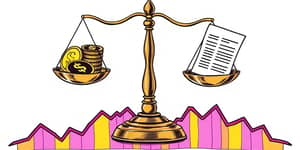
In today’s volatile markets, simply chasing high returns can be misleading. Investors need a way to distinguish between gains driven by skill and those driven by excessive risk-taking. In the complex world of investments, the Sharpe Ratio stands out as a compass, guiding portfolio managers and individual investors toward healthier, more sustainable performance evaluation.
The Sharpe Ratio, named after Nobel laureate William F. Sharpe, emerged in 1966 as a breakthrough tool for measuring risk-adjusted performance. It evaluates how much excess return an asset or portfolio generates relative to a risk-free benchmark, once volatility is taken into account. By comparing an investment to a Treasury bill or similar secure option, the metric answers a simple but critical question: are we being adequately rewarded for the risks we assume?
At its core, the Sharpe Ratio answers this by dividing the expected excess return by the investment’s volatility. performance of an investment in comparison highlights whether superior results stem from genuine skill or from riding a wave of market swings. This clarity enables investors to make more informed decisions and to compare disparate strategies on a level playing field.
Implementing the Sharpe Ratio in your analysis involves a few straightforward steps. You’ll need historical return data for your asset or portfolio and a consistent risk-free return series, commonly sourced from government bond yields. While the formula appears simple, accuracy depends on careful data handling and consistency in timeframes.
Follow these core steps to compute the ratio:
Mathematically, this process expresses mean excess return divided by standard deviation, producing a single value that quantifies risk-adjusted reward. The resulting Sharpe Ratio can be annualized or adapted to different sampling intervals, but consistency is key in comparing across assets.
In this illustrative example, a portfolio gaining 31% annually against a 2% risk-free return, with 20% volatility, achieves a Sharpe Ratio of 1.45. This indicates a strong level of risk-adjusted performance, though outliers or short histories should always be scrutinized.
Once calculated, the Sharpe Ratio offers immediate insight into your portfolio’s efficiency. A ratio above 0.75 is generally considered good, suggesting that excess returns justify the volatility incurred. When the metric climbs above 1.5, it may reflect exceptional skill, but it could also hint at data anomalies or overfitting, especially in backtested strategies.
Conversely, a negative ratio signals that the asset underperforms even a risk-free investment after adjusting for volatility. Investors should view such outcomes as red flags, prompting a deeper dive into strategy, market conditions, or data integrity. Ultimately, the Sharpe Ratio empowers you to weigh excess return per unit of risk and to differentiate between genuine alpha and leverage-driven gains.
Adopting the Sharpe Ratio can transform how you allocate capital and monitor performance over time. Portfolio managers routinely use it to compare diverse funds, strategies, and asset classes on an apples-to-apples basis. It also underpins quantitative screening models, helping to weed out opportunities that promise high returns but fail to deliver adequate compensation for their risk profiles.
Beyond pure performance evaluation, the metric aids in strategic decision-making. By analyzing how adjustments in asset weights affect the portfolio’s Sharpe Ratio, managers can fine-tune allocations for optimal efficiency. Furthermore, this measure serves as a cornerstone in constructing target portfolios, where investors aim to maximize risk-adjusted returns within specified volatility limits. comparing performance of different funds, securities becomes an objective, data-driven exercise rather than a subjective judgment.
Despite its broad adoption, the Sharpe Ratio rests on certain assumptions that may not hold for all investments. Its reliance on standard deviation implies a normal distribution of returns, which can understate risk in instruments with skewed outcomes, such as options, private equity, or hedge fund strategies. Similarly, the choice of sampling interval and risk-free proxy can materially alter results, necessitating transparency and consistency in methodology.
assumes returns are normally distributed, it may underrepresent downside tail risk. To address these concerns, practitioners often complement it with other risk-adjusted measures:
By blending these metrics, you can construct a richer risk profile and avoid blind spots. Continual refinement of your evaluation toolkit ensures that you maintain both rigor and adaptability as markets evolve.
In conclusion, the Sharpe Ratio remains a foundational tool for risk-adjusted evaluation for smarter decision, providing a clear framework to measure risk-compensated returns. While no single metric captures every facet of investment risk, mastering the Sharpe Ratio and its complements equips you to pursue performance that truly balances ambition with prudence.
References













